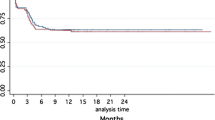Abstract
Background
This prospective, clinical, randomized, double-blind study was intended to investigate the impact of the structure and the amount of polypropylene (PP) mesh used in laparoscopic transabdominal preperitoneal hernioplastic (TAPP) on physical function and life quality.
Methods
180 male patients with primary inguinal hernia undergoing TAPP were randomized for using a heavyweight (108 g/m2), double-filament PP mesh (Prolene, 10 × 15 cm, group A, n = 60), a multifilament, heavyweight variant (116 g/m2) of PP mesh (Serapren, 10 × 15 cm, group B, n = 60), or a composite mesh (polyglactin and PP) (Vypro II, 10 × 15 cm, group C, n = 60). We compared in terms of complications (seromas, recurrence rate) and life quality (pain development, physical function). The development of life quality was documented according to the SF-36 Health Survey. The follow-up period was 60 months.
Results
The recurrence rate (2.2% overall) during 60-month follow-up was not significantly different between the groups. Convalescence in group A was slower than in groups B and C: mean-term values of the visual scales for pain development were significantly (p < 0.05) higher, incapacity for work was 8.2 days longer, and urological adverse effects were stronger. The mean-term development of life quality was significantly lower in group A up to 12th week postoperatively. There were no significant differences between groups B and C. Beyond the 12th postinterventional week the differences diminished.
Conclusions
The composite mesh does not provide an advantage concerning physical function or pain development in comparison to the multifilament, heavyweight, pure polypropylene mesh. Independently of which mesh was implanted 5% of patients are still suffering from discomfort after 5 years.






Similar content being viewed by others
References
Bittner R, Schmedt CG, Schwarz J, Kraft K, Leibl BJ (2002) Laparoscopic transperitoneal procedure for routine repair of groin hernia. Br J Surg 89:1062
Bellon JM, Bujan J, Contreras L, Hernando A (1995) Integration of biomaterials implanted into abdominal wall: process of scar formation and macrophage response. Biomaterials 16:381–387
Nyhus LM (2000) Ubiquitous use of prosthetic mesh in inguinal hernia repair: the dilemma. Hernia 4:184–186
Leibl BJ, Schmedt CG, Ulrich M, Kraft K, Bittner R (1999) Laparoscopic hernia repair—the facts, but no fashion. Langenbecks Arch Surg 384:302–311
Kumar S, Wilson RG, Nixon SJ (2002) Chronic pain after laparoscopic and open mesh repair of groin hernia. Br J Surg 89:1476–1479
O`Dwyer PJ, Kingsnorth AN, Molloy RG, Small PK, Lammers B, Horeyseck G (2005) Randomized clinical trial assessing impact of a lightweight or heavyweight mesh on chronic pain after inguinal hernia repair. Br J Surg 92:166–170
Klosterhalfen B, Klinge U, Hermanns B, Schumpelick V (2000) Pathology of traditional surgical nets for hernia repair after longterm implantation in humans. Chirurg 71(1):43–51
Bittner R, Kraft K, Schmedt CG, Schwarz J, Leibl B (1998) Risks and benefits of laparoscopic hernioplasty (TAPP)—5 years of experience in 3400 hernia repairs. Chirurg 69:854–858
EU Hernia Trialists Collaboration (2002) Repair of groin hernia with synthetic mesh: metaanalysis of randomized controlled trials. Ann Surg 235:322–332
Weyhe D, Belyaev O, Müller C, Meurer K, Bauer KH, Papapostolou G, Uhl W (2007) Improving outcomes in hernia repair by the use of light meshes—a comparison of different implant constructions based on a critical appraisal of the literature. World J Surg 31(1):234–244
Junge K, Klinge U, Rosch R, Klosterhalfen B, Schumpelick V (2002) Functional and morphologic properties of a modified mesh for inguinal hernia repair. World J Surg 26:1472–1480
Weyhe D, Schmitz I, Belyaev O, Grabs R, Müller KM, Uhl W, Zumtobel V (2006) Experimental comparison of monofile light and heavy polypropylene meshes: less weight does not mean less biological response. World J Surg 30(8):1586–1589
Scheidbach H, Tamme C, Tannapfel A (2004) In vivo studies comparing the biocompatibility of various polypropylene meshes and their handling properties during endoscopic total extraperitoneal (TEP) patchplasty: an experimental study in pigs. Surg Endosc 18:211–220
Greca FH, de Paula JB, Biondo-Simoes ML, da Costa FD, da Silva AP, Time S, Mansur A (2001) The influence of different pore size on the biocompatibility of two polypropylene meshes in the repair of abdominal defects. Hernia 5:59–64
Klosterhallfen B, Klinge U, Hermanns B, Schumpelick V (2000) Pathology of traditional surgical nets for hernia repair after long-term implantation in humans. Chirurg 71:43–51
McCormack K, Wake BL, Fraser C, Vale L, Perez J, Grant A (2005) Transabdominal pre-peritoneal (TAPP) versus totally extraperitoneal (TEP) laparoscopic techniques for inguinal hernia repair: a systematic review. Hernia 9:1–7
Langenbach MR, Schmidt J, Zirngibl H (2003) Comparison of biomaterials in the early postoperative period. Sug Endosc 17:1105–1109
Horstmann R, Hellwig M, Classen C, Röttgermann S, Palmes D (2006) Impact of polypropylene amount on functional outcome and quality of life after inguinal hernia repair by the TAPP procedure using pure, mixed and titanium-coated meshes. World J Surg 30:1742–1749
Schmidtbauer T, Ladurner R, Hallfeldt KK, Mussack T (2005) Heavy-weight versus low-weight polypropylene meshes for open sublay mesh repair of incisional hernia. Eur J Med Res 10:247–253
Heikinen T, Wollert S, Osterberg J, Schmedberg S, Bringman S (2005) Early results of a randomised trial comparing Prolene and Vypro II mesh in endoscopic extraperitoneal inguinal hernia repair (TEP) of recurrent unilateral nerias. Hernia 9:1–7
Khan LR, Kumar S, Nixon SJ (2006) Early results for new lightweight mesh in laparoscopic totally extra-peritoneal inguinal hernia repair. Hernia 10:303–308
Author information
Authors and Affiliations
Corresponding author
Rights and permissions
About this article
Cite this article
Langenbach, M.R., Schmidt, J., Ubrig, B. et al. Sixty-month follow-up after endoscopic inguinal hernia repair with three types of mesh: a prospective randomized trial. Surg Endosc 22, 1790–1797 (2008). https://doi.org/10.1007/s00464-008-9863-6
Received:
Revised:
Accepted:
Published:
Issue Date:
DOI: https://doi.org/10.1007/s00464-008-9863-6




